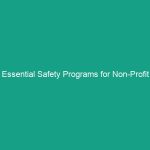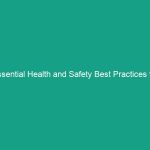Good Morning Team!
Today, we’re going to discuss an essential topic that impacts our daily operations and overall Workplace Safety: Essential Guidelines for Pushing Safety: Avoid Common Risks Today. It’s crucial for all of us to understand how to push Safety and avoid common risks to create a healthier, safer work Environment.
Understanding Essential Guidelines for Pushing Safety
When we talk about pushing safety, we’re referring to the proactive measures we take to ensure our workplace is as safe as possible. This includes identifying potential Hazards, implementing safety protocols, and cultivating a culture of safety amongst all employees.
It’s not just about following rules; it’s about understanding why these guidelines exist and how they protect us. Many employees believe that safety protocols are merely formalities, but they are critical to preventing accidents and injuries.
Key Hazards, Risks, and Safety Considerations
There are several hazards and risks associated with Workplace Safety. Here are some key areas to consider:
- Slips, Trips, and Falls: These are among the most common workplace accidents. Wet floors, uneven surfaces, and clutter can all lead to dangerous falls.
- Manual Handling: Lifting heavy objects improperly can result in serious injuries, including back problems and strains.
- Equipment Safety: Using machinery without proper Training or Safety Measures can lead to severe injuries.
- Workplace Violence: Understanding how to recognize and diffuse potentially violent situations is essential for everyone’s safety.
Ignoring these risks can lead to significant consequences, including injuries, lost work days, increased insurance costs, and even legal repercussions. It’s vital to address these risks before they turn into accidents.
Best Practices, Procedures, & Actionable Advice
To push safety in our workplace, we must implement Best Practices that all employees can follow. Here are some actionable steps:
- Regular Training: Participate in safety training sessions regularly to stay updated on Best Practices and safety protocols.
- Use Personal Protective Equipment (PPE): Always wear the appropriate PPE for your work environment, including helmets, gloves, and Safety Goggles.
- Report Hazards: If you notice a potential hazard, report it immediately to your supervisor. Don’t assume someone else will take care of it.
- Maintain Cleanliness: Keep your workspace clean and organized to reduce the risk of slips, trips, and falls.
Real-life examples can illustrate the importance of these practices. For instance, a construction site that implemented regular safety drills significantly reduced the number of injuries over time. By pushing safety, they ensured that all team members knew how to respond in emergencies.
Regulations, Standards, and Compliance
Compliance with safety Regulations is not just a legal obligation; it is essential for protecting employees. Understanding OSHA (Occupational Safety and Health Administration) standards is crucial for every workplace. Adhering to these guidelines helps us minimize risks and maintain a safe working environment.
Failure to comply can lead to severe consequences, including fines, increased scrutiny from safety inspectors, and higher insurance premiums. More importantly, non-compliance can jeopardize the health and safety of our team.
Employee Engagement & Discussion
Now, let’s open the floor for discussion. I encourage everyone to think about your personal experiences with safety protocols:
- What safety challenges have you encountered related to this topic?
- How can we improve our Safety Measures based on your experiences?
Your insights are invaluable in shaping our safety culture, and I want to hear your thoughts.
Conclusion & Key Takeaways
In summary, pushing safety is not just a responsibility; it is a commitment to ourselves and our colleagues. By understanding the risks and implementing best practices, we can create a safer workplace for everyone.
Remember the key takeaways:
- Be proactive in identifying and reporting hazards.
- Utilize appropriate safety equipment.
- Participate in regular safety training.
- Foster a culture of safety where everyone feels empowered to contribute.
Thank you for your attention and commitment to safety. Together, we can make a significant difference in ensuring our workplace remains safe and productive!


